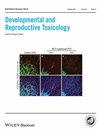斑马鱼胚胎发育过程中化合物分布的可视化:亲脂性和DMSO的影响。
Q Environmental Science
Birth defects research. Part B, Developmental and reproductive toxicology
Pub Date : 2015-12-01
DOI:10.1002/bdrb.21166
引用次数: 39
摘要
斑马鱼胚胎模型的可预测性受到胚胎/幼虫内部暴露的高度影响。由于化合物的摄取可能受到亲脂性、溶剂使用和绒毛膜存在等因素的影响,本文重点研究了它们对斑马鱼胚胎中化合物分布的影响。为了观察化合物的吸收和分布,从受精后4小时开始,将斑马鱼胚胎暴露于水溶性染料中96小时:希夫试剂(logP -4.63),吉姆萨染色(logP -0.77), Van Gierson染色(logP 1.64),甲酚耐洗紫(logP 3.5),伊红Y (logP 4.8),苏丹III (logP 7.5)和油红O (logP 9.81),有和没有1%二甲亚砜(DMSO)。另外三种化合物用于分析测定摄取和分布:阿昔洛韦(logP -1.56)、齐多夫定(logP 0.05)和酒石酸美托洛尔盐(logP 1.8)。每24小时检查一次。两种方法(可视化和特异性分析)都表明,暴露于较高的logP值会导致较高的化合物摄取。特异性分析表明,对于亲脂性化合物,90%以上的化合物被胚胎吸收。对于亲水化合物,完整卵内>90%的化合物不与胚胎或绒毛膜相关,可能分布在卵泡周围空间。总的来说,至少两次(即孵化前和孵化后)的内部暴露分析对于解释斑马鱼胚胎毒性数据至关重要,特别是对于具有极端logP值的化合物。当用可视化方法检查时,DMSO没有影响暴露,但是,这种方法可能不够灵敏,无法得出确切的结论。本文章由计算机程序翻译,如有差异,请以英文原文为准。
Visualizing Compound Distribution during Zebrafish Embryo Development: The Effects of Lipophilicity and DMSO.
The predictability of the zebrafish embryo model is highly influenced by internal exposure of the embryo/larva. As compound uptake is likely to be influenced by factors such as lipophilicity, solvent use, and chorion presence, this article focuses on investigating their effects on compound distribution within the zebrafish embryo. To visualize compound uptake and distribution, zebrafish embryos were exposed for 96 hr, starting at 4 hr postfertilization, to water-soluble dyes: Schiff's reagent (logP -4.63), Giemsa stain (logP -0.77), Van Gierson stain (logP 1.64), Cresyl fast violet (logP 3.5), Eosine Y (logP 4.8), Sudan III (logP 7.5), and Oil red O (logP 9.81), with and without 1% dimethyl-sulfoxide (DMSO). Three additional compounds were used to analytically determine the uptake and distribution: Acyclovir (logP -1.56), Zidovudine (logP 0.05), and Metoprolol Tartrate Salt (logP 1.8). Examinations were performed every 24 hr. Both methods (visualization and specific analysis) showed that exposure to higher logP values results in higher compound uptake. Specific analysis showed that for lipophilic compounds >90% of compound is taken up by the embryo. For hydrophilic compounds, >90% of compound within the complete egg could not be associated to embryo or chorion and is probably distributed into the perivitelline space. Overall, internal exposure analyses on at least two occasions (i.e., before and after hatching) is crucial for interpretation of zebrafish embryotoxicity data, especially for compounds with extreme logP values. DMSO did not affect exposure when examined with the visualization method, however, this method might be not sensitive enough to draw hard conclusions.
求助全文
通过发布文献求助,成功后即可免费获取论文全文。
去求助
来源期刊
CiteScore
1.65
自引率
0.00%
发文量
0
审稿时长
>12 weeks
期刊介绍:
The purpose of this journal is to publish original contributions describing the toxicity of chemicals to developing organisms and the process of reproduction. The scope of the journal will inlcude: • toxicity of new chemical entities and biotechnology derived products to developing organismal systems; • toxicity of these and other xenobiotic agents to reproductive function; • multi-generation studies; • endocrine-mediated toxicity, particularly for endpoints that are relevant to development and reproduction; • novel protocols for evaluating developmental and reproductive toxicity; Part B: Developmental and Reproductive Toxicology , formerly published as Teratogenesis, Carcinogenesis and Mutagenesis

 求助内容:
求助内容: 应助结果提醒方式:
应助结果提醒方式:


